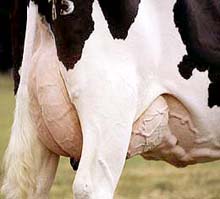Breeding mastitis out of the dairy herd

New technology developed by CSIRO Livestock Industries (CLI) will lead to the development of new strategies designed to substantially reduce the $140 million lost each year due to Australian dairy cows contracting udder infections.
Developed with support from the Innovative Dairy Products Cooperative Research Centre (Dairy CRC), the bovine immune gene microarray provides researchers with the means to rapidly assess the gene activity profiles of infected and mastitis-resistant cattle.
“Mastitis is an infection of the mammary (udder) tissue caused by a range of bacteria,” says CLI’s research team leader, Dr Ross Tellam.
“In dairy cattle this disease results in reduced milk production and altered milk quality and costs Australian dairy farmers between $120 and $150 per cow to treat.
“Identifying the genes responsible for resistance or susceptibility to mastitis opens up the possibility of selecting and breeding dairy cattle with an increased natural resistance to the disease,” Dr Tellam says.
According to the Dairy CRC’s Chief Executive Officer, Dr Paul Donnelly, it is desirable that the industry develops approaches to managing mastitis which reduce the dependence on antibiotics.
“Reducing the incidence of mastitis through improved genetics will lessen costs to individual farmers and improve animal welfare,” Dr Donnelly says.
The research is part of the Dairy CRC’s Gene Discovery Program which aims to identify, isolate and determine the function of specific dairy cow genes.
More information:
Ross Tellam, 07 3214 2476, mobile: 0409 775 044CSIRO Livestock Industries
For information on the Dairy CRC visit: www.dairycrc.com
Media assistance:
Veronica Toohey, 07 3214 2960, mobile: 0408 096 723
CSIRO Livestock Industries
Gabrielle Sheehan, 03 9607 8608, 0409 945 001
Dairy CRC
Media Contact
More Information:
http://www.csiro.au/index.asp?type=mediaRelease&id=PrmastitisAll latest news from the category: Agricultural and Forestry Science
Newest articles

A universal framework for spatial biology
SpatialData is a freely accessible tool to unify and integrate data from different omics technologies accounting for spatial information, which can provide holistic insights into health and disease. Biological processes…

How complex biological processes arise
A $20 million grant from the U.S. National Science Foundation (NSF) will support the establishment and operation of the National Synthesis Center for Emergence in the Molecular and Cellular Sciences (NCEMS) at…

Airborne single-photon lidar system achieves high-resolution 3D imaging
Compact, low-power system opens doors for photon-efficient drone and satellite-based environmental monitoring and mapping. Researchers have developed a compact and lightweight single-photon airborne lidar system that can acquire high-resolution 3D…





















